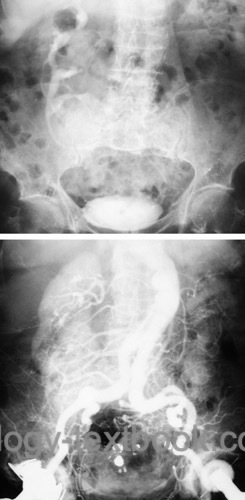You are here: Urology Textbook > Kidneys > Crossed renal ectopia
Crossed Renal Ectopia
Definition of Crossed Renal Ectopia
Crossed renal ectopia is the location of the kidney on the contralateral side in relation to the ureteral orifice location at the bladder. Often, the crossed kidney is fused with the uncrossed kidney [fig. examples of crossed renal ectopia].
 |
Depending on the form and fusion, different forms of crossed renal ectopia are possible (McDonald and McClellan, 1957):
Unilaterally fused kidneys with inferior ectopia:
Most common form of crossed renal ectopia. Both kidneys are in a longitudinal position; the crossed kidney's upper pole fuses to the uncrossed kidney's lower pole. The renal pelvises are directed anteriorly [fig unilateral fused kidneys with inferior ectopia].
S-shaped kidney:
Second most common form of crossed renal ectopia. Both kidneys are in a longitudinal position. The crossed kidney is inferior to the uncrossed kidney, and the renal pelvis is directed laterally. The uncrossed kidney is in a normal position.
L-shaped kidney:
Transversal position of the crossed kidney, the uncrossed kidney lies in a normal position with the lower pole in contact with the crossed kidney.
Disc kidney:
Crossed and uncrossed kidneys are fused with their medial borders; the lateral aspects are normal and create a disc shape. The renal pelvises point anteriorly.
Bilaterally crossed renal ectopia:
Both kidneys are crossed without fusion.
Solitary crossed renal ectopia:
The uncrossed kidney is missing.
 |
Epidemiology:
1:1000 to 1:2000. The most common form is unilaterally fused kidneys with inferior ectopia, slightly more often the crossing from left to right.
Etiology of Crossed Renal Ectopia
The etiology of crossed renal ectopia is unclear.
Signs and Symptoms of Crossed Renal Ectopia
Vesicoureteral reflux (VUR) in 20%. Only solitary crossed renal ectopia has an increased risk for malformations of the musculoskeletal system or the genital organs.
Treatment of Crossed Renal Ectopia
Only complications such as nephrolithiasis or vesicoureteral reflux must be treated.
| Simple renal ectopia | Index | Horseshoe kidney |
Index: 1–9 A B C D E F G H I J K L M N O P Q R S T U V W X Y Z
References
McDonald und McClellan 1957 MCDONALD, J. H. ; MCCLELLAN, D. S.: Crossed renal ectopia.In: Am J Surg
93 (1957), Nr. 6, S. 995–1002
 Deutsche Version: gekreuzte Nierenektopie
Deutsche Version: gekreuzte Nierenektopie